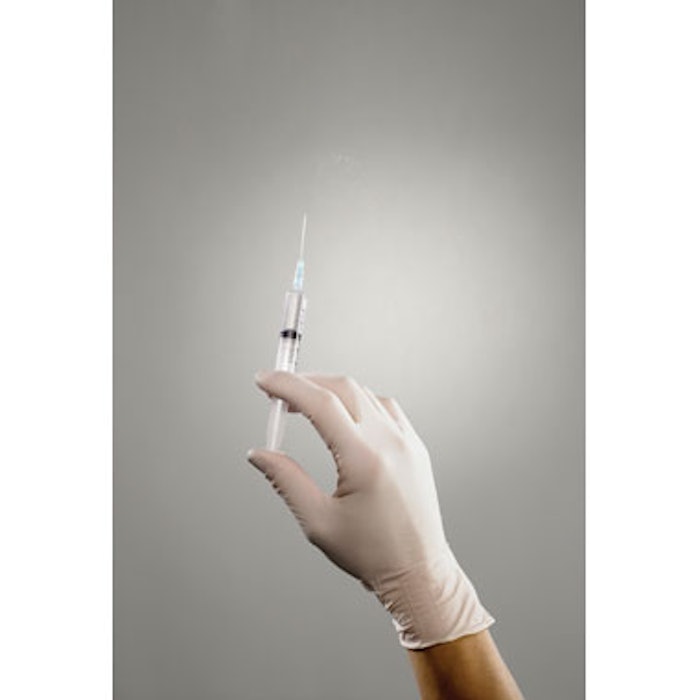
Botulinum toxin type A (BTX-A) formulations such as Botox (Allergan), Dysport (Galderma) and Xeomin (Merz) have moved well beyond their accepted roles as temporary erasers of glabellar lines, forehead rhytides and crow’s feet. Today, they are routinely employed all over the face and neck, and are being investigated for an impressive array of new indications.
New Products in the Pipeline
Although studies have shown few differences in effectiveness among the currently available brands of BTX-A, novel formulations now undergoing clinical trials could offer some new advantages, including increased ease of use, better longevity of results and needle-free delivery.
Topical BTX-A: Though there are several neurotoxin products currently in the FDA pipeline, perhaps none are generating as much excitement as RT001 (Revance). The topical gel, which combines pure BTX-A and a transmission peptide, is currently in Phase 3 clinical trials. “RT001 distributes BTX-A in the mid-dermis via a delivery peptide,” says Catherine P. Winslow, MD, assistant clinical professor at the Indiana University School of Medicine and facial plastic surgeon. “It shows promise for use with problems such as crow’s feet, where the skin is thin and distribution would be relatively effective. It also has applications for treatment of hyperhidrosis.
“It is unlikely to be as effective as injections for treatment in thicker-skinned areas, such as the forehead, or in areas where the muscle is strong, such as between the brows,” she continues. “However, as a weaker but still effective option it appears to be promising for those with needle phobias.”
Revance chief scientific officer Jacob Waugh, MD sees much wider use for RT001. “It behaves just like the intradermally injected BTX-A,” he says. “We thought we would see some differences—slower onset or less duration of action, for instance—but after treating more than 1,000 patients with RT001, tests show it acts just like injected BTX-A. Thickness or skin type seems to play no part in effectiveness. We think our topical treatment will be effective for most indications. Only those targeting deep muscles will require an injection.”
Revance is currently conducting a Phase 3 clinical trial to evaluate a single topical application of RT001 as treatment for moderate to severe crow’s feet. Researchers are employing advanced clinical methods such as electromyography to demonstrate the ability of the topical to penetrate and immobilize targeted muscle tissue. The company is also beginning Phase 2 clinical trials to determine the safety and efficacy of RT001 in the treatment of severe axillary hyperhidrosis.
As practitioners await the approval of this new topical neurotoxin, they are highlighting potential indications and voicing some concerns. Connie Brennan, RN, CPSN, CANS, CPC, director of medical aesthetic education at the Center for Advanced Aesthetics at Life Time Fitness and president/founder of Aesthetic Enhancement Solutions, questions the value of topical BTX-A. “Injections in the face are very precise, allowing exact placement at different depths in the tissue, which makes injected BTX-A a very safe and effective tool,” she says. “It will be interesting to see how the topically applied neurotoxin fares in Phase 3 clinical studies.” She speculates that a safe, effective topical could be delivered with microneedling or ultrasound in some areas.
Photo copyright Getty Images.
[pagebreak]
“A potential problem for physicians is the time the topical has to stay on the skin to be absorbed,” says Lorrie Klein, MD, founder of OC Dermatology and Euro Day Spa in Orange County, California. “You have to leave it on for 15 to 20 minutes. For most concerns, injections are faster and more accurate.” Dr. Klein is also concerned that that patients might be able to obtain topical BTX-A on their own, as they do other prescription drugs, and potentially misuse it.
Richard G. Glogau, MD, clinical professor of dermatology at the University of California, San Francisco, thinks the topical formulation may be better than injections for certain specific indications. “I’m excited about the role topical RT001 could play in controlling lip lines, for example. Injections work but are difficult to administer. Topical application has been shown to have the same safety and tolerance as injectable BTX-A, but we do need continuing studies to verify effectiveness.”
Longer Lasting BTX-A: Revance also has a new injectable neurotoxin, RT002, currently in clinical trials. The formulation features the same components as RT001. “The technology that allows topical application—marrying pure toxin to a carrier protein—has been shown to increase the duration of effect of the injectable,” says Dr. Glogau. “It is not clear why, but the average duration of effect went from three or four months to six or seven months.”
Based on initial studies, Revance began a Phase 2 trial comparing RT002 with Botox Cosmetic in January 2015. Data from the double-blind, dose ranging, active- and placebo-controlled multicenter study are expected later this year.
Liquid BTX-A: Currently available BTX-A products come in powder form that must be reconstituted with saline before use. Two new ready-to-use liquid formulations could save a little time and make storage easier.
Allergan acquired worldwide distribution rights to Neuronox from Seoul, Korea-based Medytox in January 2014. While this BTX-A injectable is available in 40 countries, it has not yet been approved for use in North America or Europe. It differs from Allergan’s Botox in the way it is produced: Botox is based on a blood protein while Neuronox is based on a plant protein. According to Medytox, this allows Neuronox to be safely stored at room temperature in liquid form.
In addition, Galderma is involved in the development of three potential BTX-A products—in late 2014, the company began testing its own internally developed liquid BTX-A. Galderma is also expected to benefit from its close alliance with biotech company Ipsen, which specializes in toxins.
In February 2014, Ipsen announced positive results of an international Phase 3 clinical trial of Dysport Next Generation (DNG), a ready-to-use liquid BTX-A, in cervical dystonia as well as the results of the European Phase 2 clinical trial of DNG in glabellar lines. The company also renewed its alliance with Harvard University based on the ongoing success of a three-year program launched in 2013. Min Dong, PhD’s Harvard laboratory is working on recombinant botulinum toxin molecules that may be better at binding with human neurons than naturally occurring forms currently used in U.S. products.
“Liquid formulations of BTX-A may make it easier to combine the neurotoxin and dermal fillers in the same syringe for use in areas like the neck where a more superficial widespread treatment makes sense,” Brennan speculates.
Photo copyright Getty Images.
[pagebreak]
New Indications
Improved Skin Texture/Quality: Some of the most exciting news in neurotoxins is the growing body of research showing that BTX-A not only relaxes muscles, it also rejuvenates aging skin. “A study just released in JAMA Facial Plastic Surgery (published online May 21, 2015) by James Bonaparte evaluated intrinsic changes seen in the skin after BTX-A injections and found some intriguing results,” says Dr. Winslow. “At least on a short-term basis, BTX-A seems to do more than just weaken muscle; it actually alters the collagen and elastin in the skin, which not only makes the skin look less wrinkled but actually makes it appear younger at the same time.”
She points out that, while the effects were not related to simple swelling or inflammation, the specific mechanism of action needs further evaluation. “Studies looking at ultraviolet damage in the skin have shown minimization of damage with BTX-A, and a link has been established with BTX-A injections and prevention of free radical release by the cells—essentially an antioxidant effect,” says Dr. Winslow. “This may account for both the lessening of ultraviolet damage and the improvements seen in collagen and elastin.”
Dr. Waugh agrees that some mechanism other than blocking acetylcholine and muscle movement is at work. “We’ve been hearing about changes in the skin associated with BTX-A injections for years. Miami dermatologist Joely Kaufman has been studying intradermal injection of a small amount of BTX-A without muscle involvement and seeing some really great effects. She will undertake a larger study later this year,” he says. “I’ve had many injections, and the thing I like most is the way BTX-A softens the skin and makes it more luminescent.”
“BTX-A does a lot of interesting things that we can’t yet explain, such as affecting pain and stopping sweating,” says Dr. Klein. “We do know that it smooths skin, and smooth skin looks better overall because of the way it reflects light.”
Ivano Iozzo and colleagues in Bologna, Spain, published an article on a particular technique they called multipoint and multilevel injection technique (MMIT) in the June 2014 issue of the Journal of Cosmetic Dermatology. They treated 223 patients with the aim of relaxing but not paralyzing facial muscles. Younger patients had complete resolution of wrinkles and older ones saw reduced wrinkling. Overall satisfaction was high for all patients, who were especially pleased with the soft, natural effects of the treatment.
Scar Prevention and Treatment: Studies such as the one by Youn Sung Kim, et al, in the September/October 2015 edition of Wound Repair and Regeneration are demonstrating the effectiveness of early postoperative BTX-A injections for minimizing surgical scars. In addition to preventing muscle pull that can create larger scars, BTX-A injections “may also improve existing keloid scars,” says Dr. Klein. “We have limited tools for this problem so any help is welcome.”
Dr. Winslow concurs. “While clinical research is still in its infancy, some studies have shown improvements in keloid scars injected with BTX-A, giving more credence to the idea of BTX-A impacting the biochemical production of collagen. Some studies have shown both in vitro and in vivo improvements in minimizing keloid formation,” she says. “This appears to be due to an impact of BTX-A on the fibroblast and expression of its proteins. This effect, like all others with BTX-A, is temporary.”
Photo copyright Getty Images.
[pagebreak]
Forthcoming Medical Uses
BTX-A began as a miraculous treatment for strabismus and has gone on to prove beneficial in treating a wide range of medical problems from the pain of cervical dystonia to relief from gustatory sweating and migraine headaches. Some of the latest medical indications being investigated include:
Atrial fibrillation (AF): Researchers at the State Research Institute of Circulation Pathology in Novosibirsk, Russia, presented data at the May 2015 annual meeting of the Heart Rhythm Society from a study of 60 patients with a history of AF who underwent invasive surgery. Only 7% of patients given a BTX-A injection experienced AF after surgery compared with 30% of untreated patients.
Mood and sleep disorders: “We’re really excited about findings of a group out of Harvard that indicate BTX-A can work on mood and sleep disorders,” says Dr. Waugh. “Europe is a little ahead of us on studying this indication.” These indications are based on research showing a reduction in depression among patients who have had BTX-A treatments and off-label injections for snoring and bruxism.
Neuropathy: A study conducted at the University of California, San Diego, published in the June 2015 issue of Anesthesia & Analgesia suggested BTX-A injections could offer effective relief from the pain and discomfort of two forms of neuropathy.
Plantar Fasciitis: “Researchers at the University of North Carolina are using injections into the soles of the feet to treat this painful condition,” says Dr. Waugh. “We think topical BTX-A will be a better treatment.”
Urinary incontinence: Studies presented at the American Urological Association annual meeting in May 2015 indicated that injecting BTX-A into the bladder muscle can reduce or even eliminate episodes of urinary incontinence. Data on 227 patients showed that about 9 out of 10 patients experienced at least a 50% drop in incontinence episodes and 40% or more had no episodes of incontinence during the four-year study period. “So much is going on with botulinum toxins it is hard to keep up,” says Dr. Glogau. “The possibilities are enough to make your head spin. When we began working with BTX-A 40 years ago, we never conceived where we would be today.”
Linda W. Lewis the contributing editor of MedEsthetics.
Photo copyright Getty Images.











